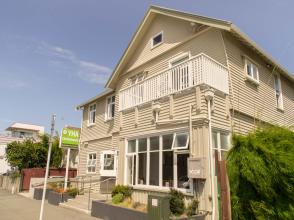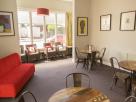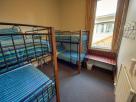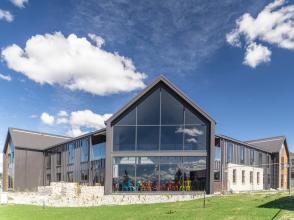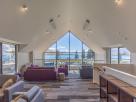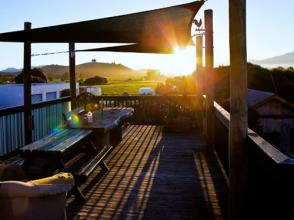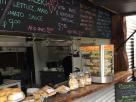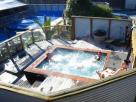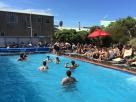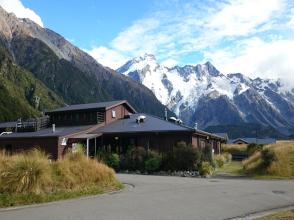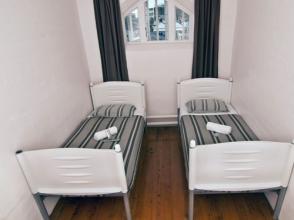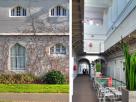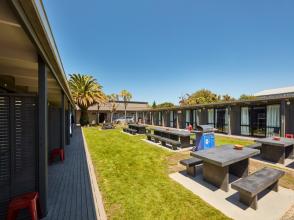Christchurch Backpackers & Hostels
Currently 29 hostels in this area
Filter by Location: View All , Akaroa (5), Christchurch (12), Kaikoura (5), Lake Tekapo/Mt Cook (3), Methven (4)

Seated on the East coast, Christchurch is the largest city in the South Island and municipal seat of the Canterbury region. It marks the point at which the landscape of the island shifts from the rolling verdant trails of the Abel Tasman and Kahurangi National Parks to the mountainous brutality of the Southern Alps, Aoraki National Park and glacier country.
Such visible change is the expected physical manifestation of the seismic fault line upon which Christchurch is built, and due to which it has suffered such awful tragedies over recent years. Despite its scars, it is a city which stands defiant in the face of nature. Its importance, beauty and enduring liveliness occupies a special place in New Zealand’s history, and no trip to the country would be complete without spending some time in this unique part of the world.
Central Christchurch
The heart of central Christchurch is consumed by Hagley Park and the famous Botanic Gardens. The streets and avenues were designed from the park outwards in the colonial grid system, and they criss-cross the Avon River which runs east to west through the city. This is considered the Christchurch CBD, and is very easy to navigate and to explore the various landmarks.
The Botanic Gardens merit a half day all on their own. They cover fifty-one acres, showcasing flowers and plants from all over the world, specialising of course in New Zealand flora, and featuring the Southern Hemisphere’s largest herbaceous border. A homage to the joy of nature in the face of its damaging force, the gardens form the basis for the tasteful development Christchurch has experienced over the last fifty years. Before leaving the gardens, be sure to visit the Canterbury Museum on Rolleston Avenue, renowned for its extensive natural and human history exhibits.
Brits visiting Christchurch will find straight away that the street names have a very familiar air. This is no accident. The two men credited with founding modern Christchurch - Captain Joseph Thomas and his surveyor, Edward Jollie – wanted to evoke a “Britishness” to make émigrés from the old country feel more at home. Accordingly, classic English cities crop up frequently in the town map – Hereford, Worcester, Canterbury, and of course Oxford and Cambridge.
There are also nods to other British colonial adventures of the eighteenth and nineteenth centuries, with street names such as Madras and Bardadoes (the traditional spelling). In this respect, Christchurch typifies that need shown by early British settlers to stamp their mark on the country. Head Eastward from the Botanic Gardens up Gloucester Street, and you’ll be drawn by the wonderful waving glass facade of Christchurch Art Gallery. The gallery came into its own in 2010 and 2011, not simply for featuring some of the world’s greatest works of art, but providing the city with some respite from the earthquakes, and acting as a temporary coordination centre. Also nearby are two YHA Hostels – Rolleston House on Worcester Boulevard, and Christchurch Backpackers on Hereford Street.
From the gallery, you have a choice of two monuments along Cambridge Terrace as it follows the Avon river. To the South, the Bridge of Remembrance is dedicated to New Zealanders who perished in the Great War. Surviving the earthquakes, the Bridge was strengthened in 2015 and continues to form a focal point for war memorials, especially on Anzac Day.
To the North of Cambridge Terrace you will find the Kate Sheppard Memorial. This impressive bronze memorial celebrates one of the leading campaigners for women’s suffrage, and forms the centrepiece to an attractive landscaped garden on the banks of the Avon.
From here, it is a short walk westward along Worcester Street to the impressive, not to mention indefatigable, Christchurch Cathedral. Constructed between 1864 and 1904, it has withstood countless earthquakes over the decades, and unlike its architectural forebearers in Dresden and Leipzig which ill-sighted Brits preferred to carpet bomb out of existence, Mother Nature finally took its toll on Christchurch Cathedral. The massive 2010 quake caused irreparable damage, and it was deconsecrated in lieu of the rebuilding project. Not quite on the scale of Notre Dame, it is still expected to run to over $100 million.
A short walk North will take you to New Regent Street Precinct. This popular pedestrianised area is quite unique from the surrounding districts, built in a Spanish style and protected as a heritage site. In addition to shops, there are also some wonderful independent restaurants, bars and coffee hangouts. By way of a counterpoint to the elegant surroundings of New Regent Street, head instead to the Re:Start Container Mall on Cashel Street, not far from the Bridge of Remembrance.
The Re:Start project was in response to the 2011 earthquake aftermath, where many businesses were forced to closed due to damage. With no prospect of their properties being rebuilt, shipping containers were instead used as temporary premises, and have since grown into an iconic display of defiance, the district itself becoming a monument to human endurance, community and spirit in the face of such destructive natural forces.
Further afield
Only once you start exploring the surrounding areas can you fully appreciate that Christchurch is in fact a coastal city, something not apparent if you’ve flown in to the international airport. Even driving down Highway 1 can be quite deceiving, as the road sweeps inland once you drive past Kaiapoi. And whilst the city’s proximity to the ocean is behind some of geological forces which have plagued it for so many centuries, it does nevertheless mean there are some lovely coastal towns, beaches, bays and harbours to explore.
New Brighton
Six miles out from Christchurch lies another homage to a British cousin. This lovely beach town is livelier than its official population of just under three thousand would suggest, swelling considerably in the summer as people flock the spotless beaches. With impressive waves forming from the ocean as it meets Pegasus Bay, it’s also a hot spot for surfers, and if you’re a beginner there are numerous schools and rental shops which will help you give it a try. After walking the 300 metre long pier, you can take a stroll along the Avon River as it nears its end towards to ocean, then explore the Travis Wetlands heritage park for a chance of spotting the rare and interesting Shoveler Paradise duck, native to New Zealand. And if you’re visiting on a Saturday, be sure to check out the Saturday market along the Brighton Mall.
Lyttleton
A short ten mile drive south from Christchurch takes you to the harbour town of Lyttleton. One of the earliest European settlements in the Canterbury region due to its sheltered harbour and fertile, flat surrounding land, it has been decorated with a New Zealand Historic Places designation. The drive into Lyttleton takes you through a 2000 metre long tunnel, an impressive feat of engineering which survived all the recent earthquakes. The town itself is host to an eclectic mix of shops, restaurants and bars, all independently owned and popular with writers and artists. At the harbour you’ll find cruises to take you dolphin spotting around Quail Island.
Highway 75
If you want to fully explore the tip of the Canterbury peninsula, take Highway 75 south from Christchurch. The landscape becomes increasingly desolate, passing through small settlements Tai Tapu and Motukarara, until the drive past Lake Forsyth ushers you into the most remote parts of the region. 50 miles from Christchurch, the highway ends at the sheltered bay town of Akaroa. Don’t be fooled by its isolation though. There are plenty of restaurants and activities to enjoy, and it’s well worth the drive just to experience another little rugged tip of New Zealand spilling into the ocean. One of many.

